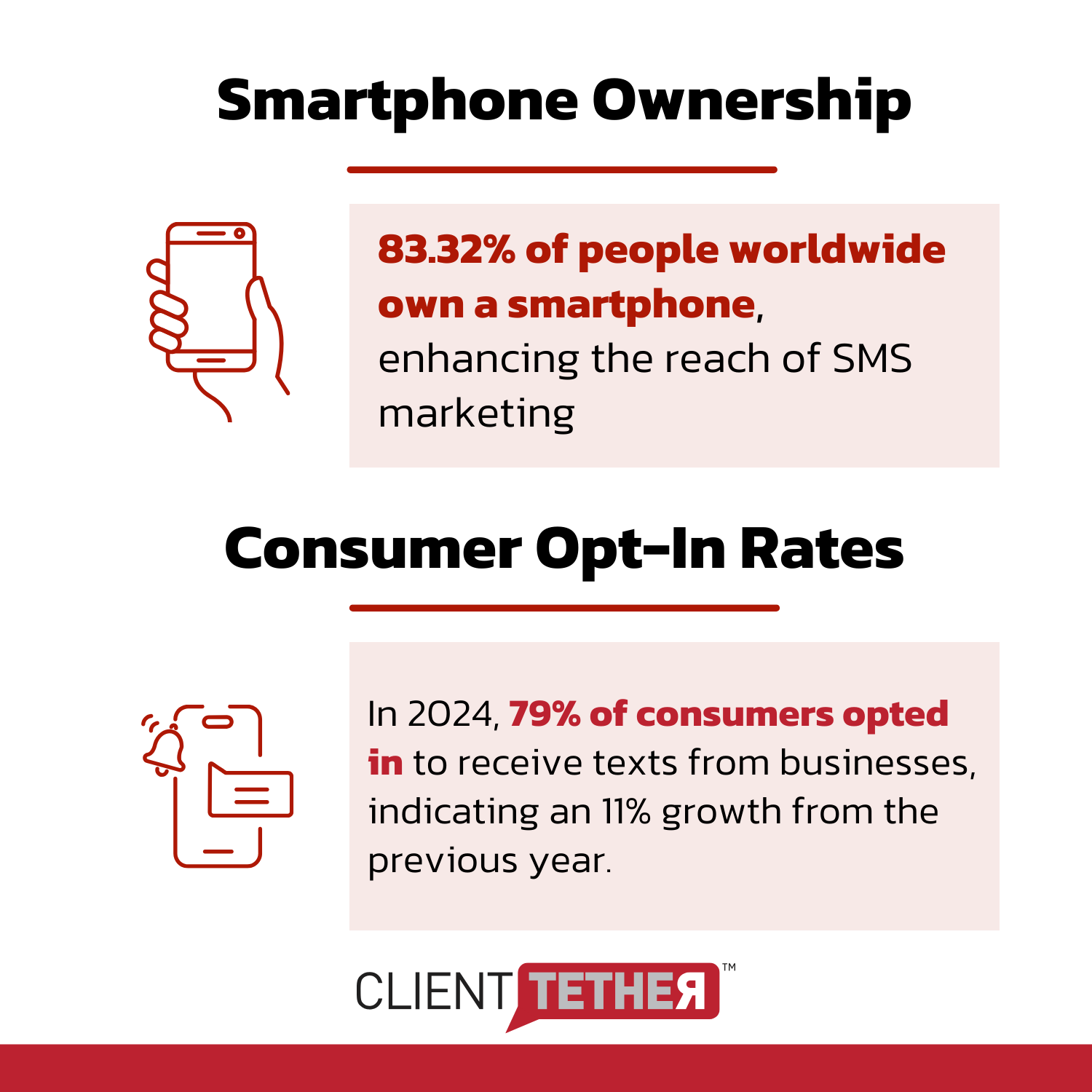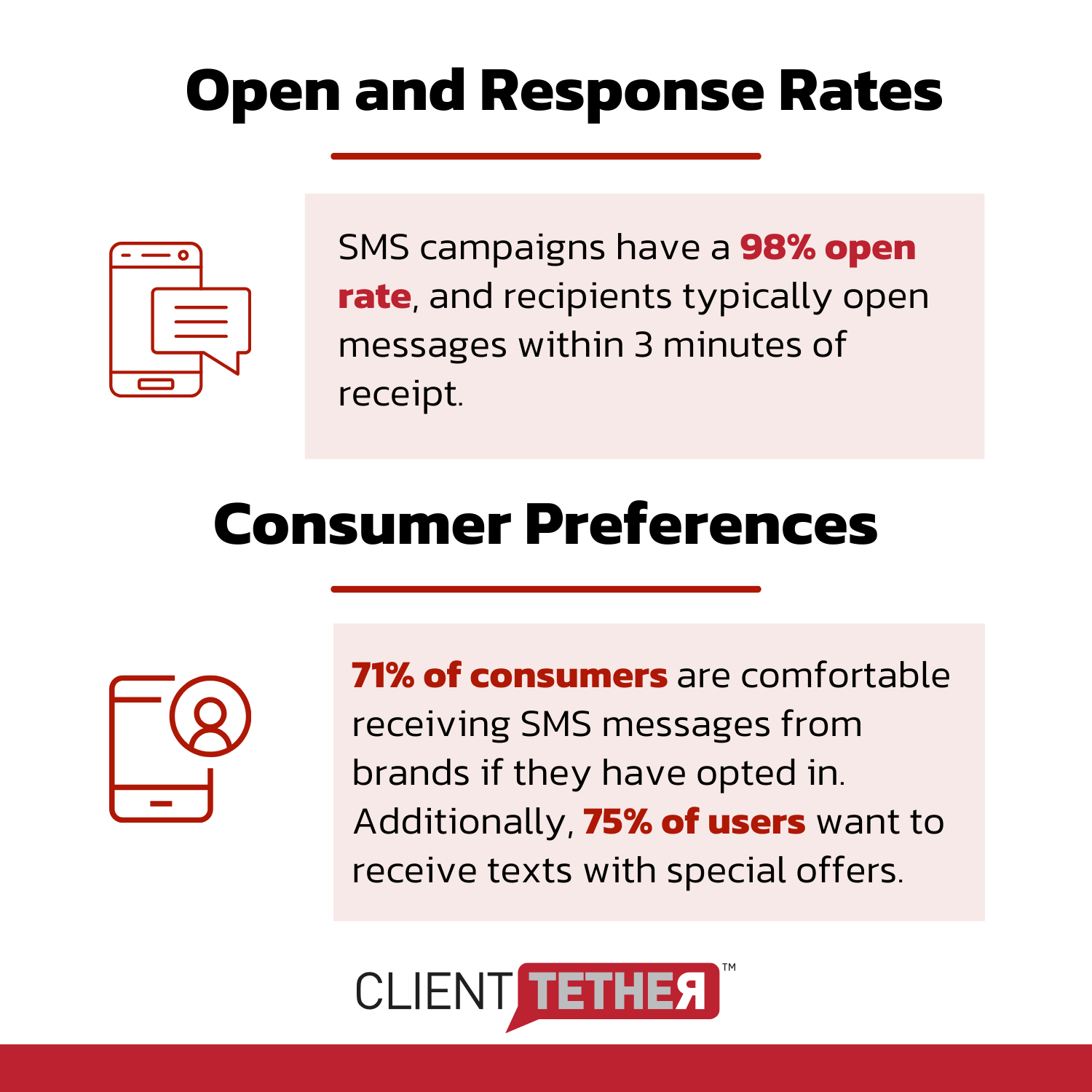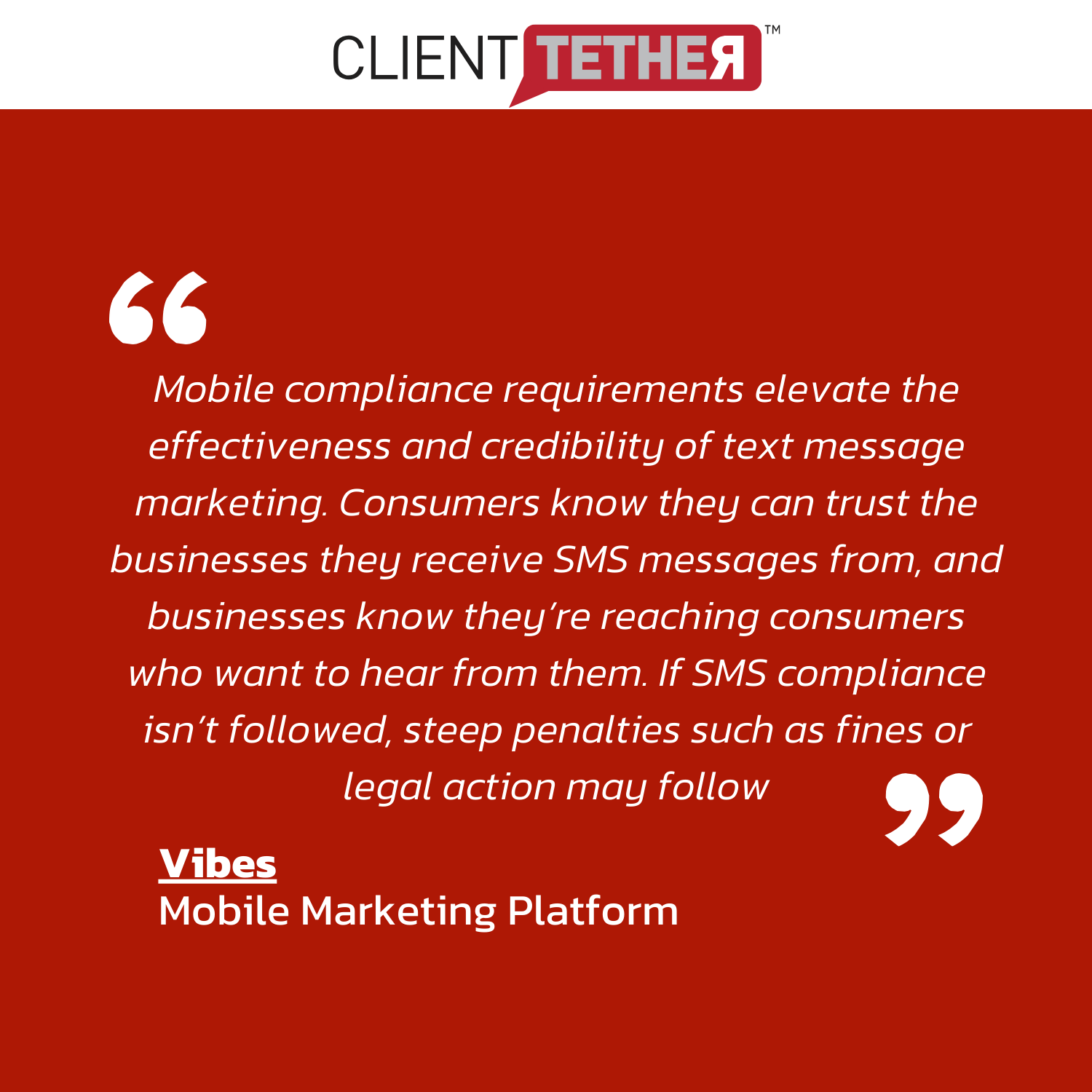Maintaining TCPA Compliance for SMS Messaging: A Comprehensive Guide for Franchise Systems

When a single violation can cost up to $1,500 (willful violations), and each franchise can often send hundreds of messages daily – the risks of not maintaining TCPA (the Telephone Consumer Protection Act) compliance stack up quickly.
Having worked with hundreds of franchises through ClientTether, I’ve seen firsthand how challenging it can be to navigate the complexities of TCPA compliance – especially if you don’t have franchise software that helps automate this process. But it’s not just about avoiding fines. It’s about creating a transparent, trustworthy relationship with your customers—a relationship built on consent and respect for their privacy. That relationship fuels loyalty, increases online reputation, and can yield higher referral results – so we can also think of this as a revenue generation exercise as much as a compliance issue.
Before we dive into the technical details, I want you to think of TCPA compliance like coaching a a football team. Imagine trying to compete at a high level (High school varsity or college) without following the rulebook. You might win a few games on raw talent, but eventually, the penalties catch up with you. Think of the Browns. They lead the league in penalties and have one of the worst records in NFL history…Coincidence? It’s the same with TCPA. Sure, you might get by for a while, but without proper systems in place, eventually, a violation will come back to haunt your business.
By following the right strategies—clear opt-ins, transparent messaging, and automated opt-outs—your franchise can stay compliant and keep building strong relationships with your customers. There is no reason to fear TCPA compliance. You simply need to understand the rules of the game.
In this guide, we’ll break down the basics of TCPA compliance for SMS messaging, offering actionable steps to ensure your opt-in forms are airtight, your messaging is clear, and your opt-out processes are seamless. Let’s get started.
The Importance of Clear Opt-In Forms
One of the most critical aspects of maintaining TCPA compliance is ensuring that your opt-in forms are clearly visible and compliant with the required opt-in language. This might seem straightforward, but in practice, many businesses unintentionally fall short. In fact, during a recent webinar sign-up, I noticed a registration form that wasn’t TCPA compliant, and this was from a reputable organization. It’s an easy mistake to make, but the consequences can be costly. Furthering the point, our team has been auditing the Franchise industry both at the parent (FranDev) and the unit level, and just under 50% of all web forms we look at are TCPA compliant.
Visibility Is Key
When it comes to opt-in forms, placement and visibility are everything. The opt-in statement needs to be positioned in a way that it cannot be overlooked.
My rule of thumb? Place the opt-in statement directly between the form and the submit button. If it’s hidden below the button or displayed in a tiny font, it’s likely that your customers won’t see it—and that puts your business at risk. Not only does the opt-in need to be clear, but the language itself must be compliant. This means including the required phrases that make users fully aware of what they are agreeing to. Your form should clearly state that “by submitting this form [the user] agree(s) to…” and include receive texts, calls, and emails, “messaging rates may apply,” that “messaging frequency and type may vary,” “reply stop to cancel,” and you need to directly reference (Links are preferred) your privacy policy and terms of service. These phrases are non-negotiable under TCPA, and failing to include them could land your franchise in hot water.
Why SMS Compliance Matters to the Franchisor
Franchises often deal with high volumes of customer data and messaging across multiple locations. Ensuring TCPA compliance is crucial for safeguarding your business from litigation and fines, but it’s also essential for maintaining trust with your customers. A transparent opt-in process tells your customers that you respect their privacy and will only communicate with them on agreed-upon terms. At ClientTether, we’ve helped countless franchises streamline their opt-in processes to remain compliant while keeping the customer experience smooth.
The lesson here is simple: keep your opt-in forms front and center, and make sure the language is crystal clear. Anything less could cost your business far more than just a few customers—it could lead to expensive fines and long-term reputational damage.
By taking the time to ensure that every customer who opts in knows exactly what they’re signing up for, you’re not only protecting your franchise but also creating a more trustworthy and transparent relationship with your customer base.
Best Practices for Managing Opt-Outs
A well-structured opt-out process is not only a legal requirement under the TCPA but also a vital element in maintaining trust with your customers. Similar to managing opt-ins, mishandling opt-outs or failing to honor them promptly can also lead to significant penalties. But this is also the fastest way to violate a client’s or prospect’s trust. That’s why SMS compliance automation is key, especially for franchise systems handling large volumes of customer communication across multiple locations.
The Role of Automation in Unit Level SMS Opt-Out Management
In a busy franchise operation, manually managing opt-outs is not only inefficient but risky. Bear in mind that if you’re using personal cell phones to text customer directly for business purposes, you are under the same restrictions and requirements.
There’s too much room for human error, which can result in accidental violations. For example, if a customer texts “STOP” but your system (or your team) doesn’t immediately remove them from your SMS list, you could be held liable for every text sent after the opt-out request. This is where automation comes in, ensuring that opt-out requests are processed instantly and accurately, without the risk of oversight.
At ClientTether, we’ve seen firsthand how effective automated opt-out systems can be in reducing risk and improving customer experience. With a well-designed CRM, the moment a customer replies with “STOP,” they are automatically removed from your messaging list, and the system ensures no further messages are sent. This immediate response not only keeps you in compliance but also demonstrates to your customers that you respect their communication preferences.
Manual Texting: A Hidden Danger for Franchises
One of the biggest pitfalls for franchises is allowing team members to send manual texts from personal devices or third party systems that live outside of your franchise software. While it may seem harmless for Bob, your sales manager, to shoot off a quick text to a customer, doing so without proper SMS opt-in or opt-out tracking can lead to major compliance issues. If Bob forgets that the customer opted out weeks ago and sends another text, that could result in a $1,500 fine per message. This risk is compounded in franchise systems where multiple employees are handling customer communication.

Automation eliminates this risk. By using a centralized system to manage all SMS communications, you ensure that every team member is compliant with TCPA regulations and that no customer ever receives an unwanted text. This centralized approach not only reduces legal risks but also fosters better communication practices across the entire franchise.
There are also many 3rd party texting platforms that only provide SMS services. With the new regulations coming in January 2025 regarding dual opt-out requirements, these third-party systems may create significant liability for franchise systems.
Tips for Effective Opt-Out Handling
- Automate Opt-Outs: Ensure that all opt-out requests are handled automatically and in real-time. Never leave this process to manual tracking.
- Provide Clear Instructions: The first SMS message to every customer should include clear opt-out instructions, such as “Reply STOP to cancel.” This transparency is not only required by law but helps build trust with your customers.
- Audit Your Process Regularly: Periodically review your opt-out processes to ensure everything is functioning correctly. This can prevent any issues from slipping through the cracks.
- If you’re reaching out to a client within an appropriate amount of time (90 days for prospects and 18-months for customers) but it has been a while since you last spoke – provide a reminder of your text opt-out as well (i.e. Reply “STOP” to cancel texting”).
Frequency and Content Disclosure Requirements
Ensuring compliance with the TCPA doesn’t stop at opt-in forms and opt-out processes. One critical aspect of compliance is notifying consumers about the nature of your communication plans with them and reminding them that they may incur costs with texts being delivered to their phone. These disclosures are required by law and help to keep your franchise transparent with customers while avoiding costly delays in TCR approval to start using texting with your business.
Required Phrases for Compliance
Two phrases must always be included when collecting opt-ins for SMS messaging:
- “Messaging rates may apply” – This informs the customer that they may be charged by their mobile provider for receiving your messages. Even though most consumers are on unlimited messaging plans, it’s a crucial legal requirement to state this explicitly.
- “Messaging frequency and type may vary” – Since franchises typically send both marketing and transactional messages, the frequency of communication can change based on customer activity. This phrase helps ensure that customers understand they could receive multiple messages over time, making it clear that there isn’t a fixed frequency for the texts. This also informs them that the type of messaging (transactional or marketing) may change over time as you communicate with them.
Including these phrases in your opt-in forms isn’t just a box to check for compliance; it’s part of building trust with your customers. By setting clear expectations upfront, you reduce the likelihood of complaints or opt-outs later down the road. When a customer knows what to expect from your messaging, they’re more likely to stay engaged and less likely to feel overwhelmed by too many texts.

How to Implement These Disclosures
Your opt-in forms should clearly display these required phrases, ideally between the last form field and the submit button, so users can easily see them before agreeing to receive messages. It’s best practice to bold or italicize these key statements to ensure they stand out.
Moreover, if your franchise frequently sends different types of messages (such as promotions, reminders, or transactional alerts), be sure to clarify this in your opt-in form. For example, “You may receive marketing offers, appointment reminders, or other transaction-related notifications.” The more specific you are, the better protected your franchise will be from any misunderstandings or complaints.
There are several brands in franchising that have developed solid opt-in disclosures that can be used as great examples. Authority Brands has implemented these opt-in statements on some of their franchise development lead forms. Check out their Color World Painting website for a good example.
Transparency Builds Trust
Ultimately, transparency in how you handle SMS communications is key to both compliance and building strong customer relationships. By clearly disclosing potential messaging costs and variable frequencies, you show that your franchise respects your customers’ time and preferences. It’s a simple step, but one that protects your business from fines and helps retain customer loyalty.
With these compliance guidelines in place, you can ensure that every message you send meets legal requirements and continues to foster positive engagement with your audience.
Handling Old or Dormant Leads
One of the most common mistakes franchises make is assuming that a previous opt-in grants them unlimited permission to send SMS messages indefinitely. Under TCPA guidelines, re-engaging dormant leads—those who haven’t interacted with your franchise for an extended period—requires careful attention. If you fail to treat these leads as new contacts, you risk significant fines for non-compliance, not to mention damaging your customer relationships.
Understanding Dormant Leads
Dormant leads are those who initially opted into your communications but have since gone quiet—sometimes for months or even years. For example, consider a franchise candidate who showed interest two years ago but hasn’t interacted with your brand since. Under TCPA rules, that original opt-in may no longer be valid, especially if significant time has passed. Reaching out to these dormant leads without treating them like new prospects could land you in trouble. A good general rule of thumb is to treat any lead that hasn’t engaged in over 3 months as a new contact. You should include an opt-out statement in your first text to them – even though you did the same things 3 months ago. You should also reduce the number and frequency of text messages you send them. They may not even remember opting in to learn more about your business 90 days ago. It’s a good best practice to remind them of how they reached out to you (facebook, website, LinkedIn), and inquire about their interest.
For customers and previous customers, you should provide the same courtesy if it has been months since you last communicated with them.
First Contact Rules for Dormant Leads
If you decide to reach out to a dormant lead, it’s essential to treat the first message as if it’s the first time you’ve contacted them. The message must include:
- Your business name.
- The reason for reaching out.
- A clear opt-out option, such as “Reply STOP to cancel.” This approach ensures that you’re staying compliant while also giving the lead an opportunity to confirm their interest or easily opt-out if they no longer wish to receive messages. Transparency is key, as failing to identify your franchise clearly or provide an opt-out option can lead to costly fines.
Example Approach
Let’s say you’re re-engaging a customer named Susan, who signed up two years ago but hasn’t responded to a message for 6 months. Your message should look something like this:
“Hi Susan, this is [Franchise Name]. We’re reaching out to let you know about new opportunities to own a business in your area. Reply STOP to opt out at any time.”
This simple message follows TCPA guidelines while keeping the customer informed and in control.

Stay Transparent, Stay Compliant
When re-engaging dormant leads, treating them as new contacts isn’t just a legal obligation—it’s a way to show respect for their preferences and their time. By being upfront about who you are, why you’re reaching out, and how they can opt-out, you build a stronger foundation for future engagement. In the world of franchises, where managing customer data across multiple locations can be complex, franchise software like ClientTether can make all the difference in ensuring compliance while boosting customer satisfaction.
Taking these steps protects your franchise from legal risks while also helping you reconnect with leads who may still be interested in your services. Properly managing dormant leads is not just about compliance—it’s about reigniting relationships in a way that builds trust and loyalty.

Common Pitfalls to Avoid When Sending SMS Messages
Despite the best intentions, many franchises unknowingly make mistakes when managing SMS communications, leading to costly TCPA violations. Understanding and avoiding these common pitfalls will not only help your business remain compliant but also improve your relationship with customers by ensuring transparency and respect for their communication preferences.
1. Failing to Provide Clear Opt-Out Instructions
One of the most frequent mistakes is neglecting to provide clear opt-out instructions in every SMS message. Under TCPA rules, every communication must offer an easy way for recipients to opt-out, typically by replying with “STOP.” This opt-out reminder should be in your first message. Without this, even if your initial opt-in was compliant, you could face penalties, such as having your text messages blocked. It is much better to ensure compliance than to be worried about sending a first message that doesn’t seem “personal”.
2. Using Personal Devices and 3rd Party Tools for Business Texting
In many franchise operations, sales or customer service teams might use personal devices or tools not connected to your franchise software to communicate with customers, especially when handling a large volume of leads. This approach can quickly spiral out of control. If an employee accidentally sends a message to a customer who has opted out, your franchise could face significant fines. Centralizing all SMS communications through a dedicated, TCPA-compliant Franchise CRM system—like ClientTether—eliminates this risk. With automation, you ensure that no messages slip through the cracks and that opt-outs are respected and enforced across the entire franchise system.
3. Sending Messages Outside Permitted Timeframes
The TCPA has strict guidelines about the timing of SMS messages. Messages sent before 8 a.m. or after 9 p.m. in the recipient’s time zone are considered violations. Franchises operating across multiple locations and time zones can find this particularly challenging. To avoid issues, automate your messaging system to adjust for time zones, ensuring that no messages are sent outside the permitted hours.
4. Overwhelming Customers with Too Many Messages
Even if your opt-in forms and messages are TCPA-compliant, overwhelming customers with frequent messages can still harm your brand’s reputation and lead to opt-outs. Be mindful of message frequency, and make sure customers know what to expect in terms of communication volume. Including the phrase “Messaging frequency may vary” in your opt-in form, as required by TCPA, helps set expectations, but following up with responsible messaging practices is essential to keep customers engaged. Remember – once the consumer has opted out of texting from your company, you lose access to that high-impact channel of communication until they manually allow you to text again by replying “Start”, “Uncancel”, etc.
5. Ignoring Dormant Lead Best Practices
As discussed earlier, reaching out to dormant leads without treating them as new contacts can result in violations. If you haven’t interacted with a lead in over 3 months, it’s critical to follow first-contact rules again, including clear opt-in and opt-out information.
Final Thoughts
Avoiding these common mistakes isn’t just about staying on the right side of the law. It’s about showing your customers that you respect their time, privacy, and preferences. By automating key processes, reviewing compliance regularly, and making sure your team understands the rules, your franchise can stay compliant while continuing to grow.
Taking the time to implement these best practices will save you from unnecessary legal headaches and help foster trust with your customers—keeping your business both compliant and thriving in today’s competitive market.






